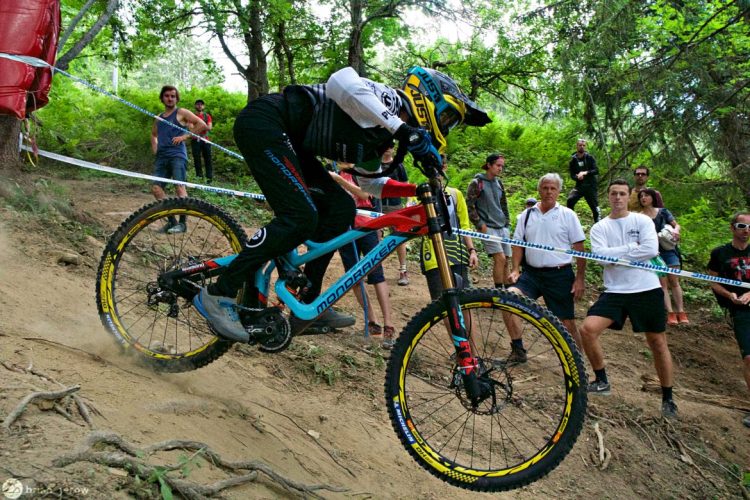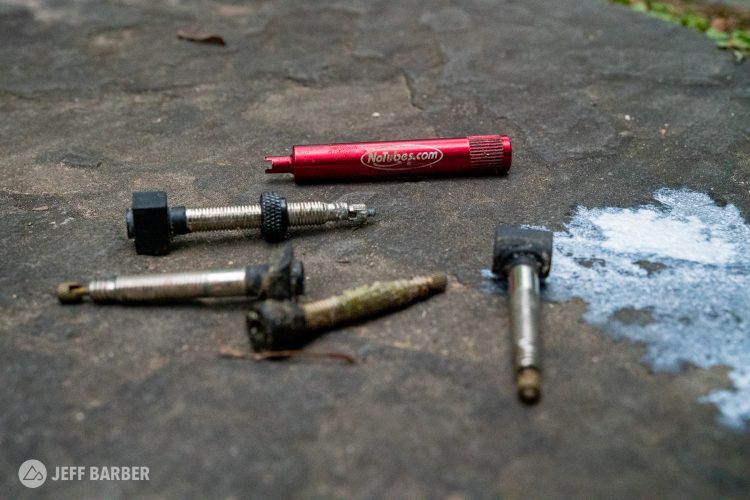Tires. We know when they work, we know when they don’t. Not all of us understand why.
When I raced downhill, I had my favorite tires that I trusted to keep me upright. I was also aware of the tires that didn’t work so well, but it was difficult for me to figure it out. I knew from trial and error (usually crashing) which rubber to avoid. The pivotal shift in my understanding of tires came from an unlikely source — a friend of mine who worked as a bike mechanic. He was a mid-pack sport class racer, and his technical knowledge was outstanding.
At the time, I purchased a pair of front and rear specific tires from a major brand. After my first real test of the tires on a steep track, I noticed two things. The front tire worked very well, while the rear tire was absolute garbage. It left me a bit confused. Both tires came from the same brand, both were designed by the same person, and both had the same rubber compound. I went back to the shop where my friend worked and told him about my experience. He quickly snarked that the rear tire didn’t have any stand up braking traction and that I was stupid for buying it. No arguments here.
Now, this should have been obvious to me had I been more tech-savvy than I thought I was. It was at that point at which I took tire design more seriously. His comment, “Stand up braking traction” was something I hadn’t heard before. Nobody talked about it, and that’s probably why it resonated with me. The original version of this rear tire had a huge channel down the middle that didn’t provide any biting traction. The tire only became usable when it was leaned over onto its shoulder lugs.
As I dove deeper into understanding tire design, I had to start from scratch and re-examine what I thought I knew. I broke down the characteristics of riding downhill and how each end of the bike really had different roles to play in traction. What I learned back then still applies now, and hopefully, it will help shed some light for those who are as confused as I was.
Stand up braking


The light bulb in my head went off when he said those three words. I discovered that in order for a rear tire to have excellent braking traction when your bike is standing straight up — that is, leaning neither left nor right relative to the surface of the ground — it needs a large block down the middle. The trailing edge has to be squared off so when the wheel locks up, this edge acts as a plow. Sure, we shouldn’t be riding with a locked-up rear wheel, but you’ll sometimes have to “panic” brake to control the back of the bike. The leading edge is what hits the ground first, so a ramped edge here will reduce rolling resistance. Too much ramp, however, will cause the tire to float. In the absence of a large center block, a tire will work well with a small gap cutting the knob into two blocks, but the gap must be small. Think of a snowplow with a gap down the middle. Where is that snow going?
Cornering traction

A typical downhill trail has some corners that aren’t banked, and this means that you have to lean the bike over and sideload the tires. There are two things at play here: are you braking through the corner, or are you rolling through it? Those two factors will determine intermediate knob design. Obviously, tire makers can’t design a tire for each riding characteristic, but a tire that does both is easily achievable. The intermediate knob should be squared off on the outside edges, running parallel with the center knob. The knob shape here can just be an offset square shape, but designers have the option to alter the shape a little. In short, this knob is serving double duty as it aids in braking and sideload traction, but it has to be good at both.
Shoulder “lugs” come into play here as well. These generally should be firm so as to not collapse under hard loads. They should have sharp edges and be deeper than any of the other knobs. The only caveat comes when you are exclusively riding in mud or soft ground, then you can get away with using a less supportive or smaller shoulder lug. If there is one area of the tire to feature a harder compound, this is it. I’ve ridden tires that collapsed under side loads and it resulted in me feeling gun-shy every time I cornered. Not good.
A good take-home message that a fast racer once told me was that a rolling tire has more traction than you think. That seems kind of obvious, but what he meant is that I should probably lay off the brakes.
Front vs. rear tires

Many good tire designs can be used front or rear. However, understanding the basics of what each end of your bike is doing will help you find the perfect fit. The front of your bike does the majority of the steering. No surprise there. But what it also does is hard braking. Here is where the tire’s knob design should be visibly directional. Unlike a rear tire, the front tire works better with a center channel. Additionally, the intermediate knobs should have squared off outside edges. The functionality of the knobs here is primarily for side loading and steering.
The back of your bike is where controlled braking is done. Like I stated earlier, the rear tire is a plow. The back wheel is trailing and helps control the bike while being less weighted, similar to a rudder. The front of the bike is doing the majority of the power braking, directing the bike under load.
If you look at motocross bikes, for comparison sake, something different is happening. Those bikes are being steered by the back tire as they are rearward weighted in the corners. Mountain bikes are the opposite. We ride more forward, so the front tire is seeing the majority of the loads and traction requirements.
I believe that front tires should feature a rounder side profile than rear tires. This is because there is so much more weight on the front wheel, so you don’t want the front tire folding under you. On the back, you’ll want the side lugs engaging sooner and biting into the ground for better control. If you are riding aggressively, positioned in the middle of the bike, then there is a lot less weight on the rear wheel. There is less concern over the side lugs folding on a rear tire.
Tire direction
It should be straightforward as to the direction the tire should be rolling with ramped leading edges and squared off braking edges. If in doubt, there is usually a directional arrow on the sidewall. However, there are those of us who require climbing traction over anything else, and for those people, the rear tire can be reversed. I would never do this unless I was entering a technical climbing competition. Braking traction far exceeds climbing traction, even on cross country bikes. The perfect tire has sufficient climbing traction with superb descending traction.
Other factors

Most of these tire characteristics I reference relate to steep and loose tracks with sharp turns. If your hometown trails are flatter and harder-packed, then you can choose from a much wider selection of designs.
The surface area of the knobs has an effect on performance. The more surface area, the more the tire will float. This is great if you ride hard-packed trails where a larger contact patch and a firmer knob would benefit in those conditions. If it’s steep and loose, then you should be running a taller, sharper, narrow knob design. Deep, sticky mud? Choose a narrower tire or very tall knobs like a spike. A narrow rear tire will bite into the mud and slice its way to the bottom, where a fatter tire will float on top.
Rubber compounds are also very important to consider when choosing a tire. In motocross, they break them down into soft, intermediate, and hard. Those terms don’t describe the rubber compounds, but rather the terrain where the tires will be used. Though the simple block shapes of an MX tire can be quite effective for use in mountain biking, that’s where the similarities end. Generally, mountain bikers will use soft rubber for soft terrain, harder rubber for hard ground, and so on. If you are a racer, or you like to travel to ride, then I would suggest keeping multiple sets of tires with varying rubber compounds on hand. For most riding, an intermediate conditions (mixed) tire compound will suffice.
Conclusion
About ten years ago I worked with a major tire brand, helping redesign and test a few of their tires. At the time, I remember the engineer at the company telling me that not much thought goes into designing tires. He summed it up by saying that tires were designed to look good and not much else. When I asked about their moto division, he said that dirt bike tires were tested by pro racers on a closed course, stopwatch in hand, and engineers on site.
For a design to work well, it really doesn’t need weird shapes, especially for rear tires. Industry-wide understanding of good tire design has come a long way since that era when there were literally a handful of decent tires on the market. Fortunately, the brands that brought terrible tires to the market, failed to adapt and are no longer with us.






















16 Comments
Dec 30, 2021
Dec 28, 2021
I'd add that when a tire has a big gap between outside lugs next to the more medial lug, you're going to get a weird slip zone. Sometimes that can be terrifying.
Dec 29, 2021
Dec 29, 2021
Dec 29, 2021
Might that be backwards? Soft ground needs something hard (and tall) to punch through it and dig in; hard ground (including rock) needs something soft to conform for maximum contact (and short for minimal squirm)
Dec 29, 2021
Dec 30, 2021
Why does a rounder profile decrease the chance of folding?
Jan 30, 2022
Mountain Bike tires have always been terrible until the last 10 or so years. So this all makes since.
Dec 28, 2021
Dec 29, 2021
If you tend to drive the front hard into corners then maybe a more "rail" like tread like a DHF or Butcher would suit, but you would get a bit more of that drifty feel before transitioning to the side knobs on leany turns
Dec 29, 2021
Jan 1, 2022
I tried reversing as you suggested. This time it feels like that the rear has too much grip and slow rolling and the front has more play with less grip. Is this how it should be?
Dec 28, 2021
Dec 29, 2021
Jan 1, 2022
Mar 27, 2024